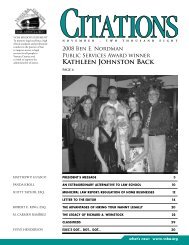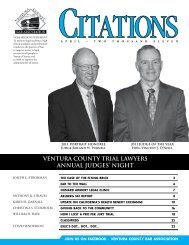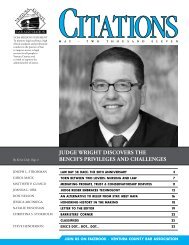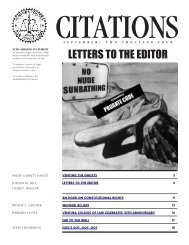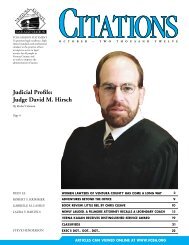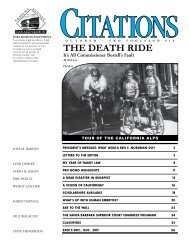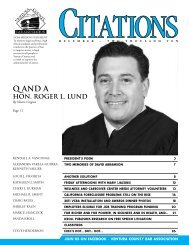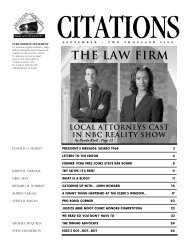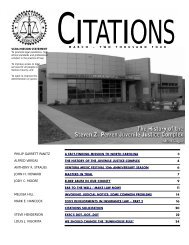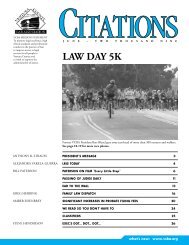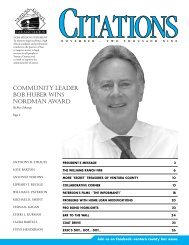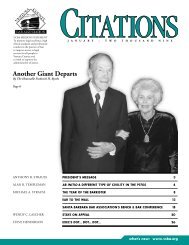ALERT: FILING PROCEDURE CHANGED - Ventura County Bar ...
ALERT: FILING PROCEDURE CHANGED - Ventura County Bar ...
ALERT: FILING PROCEDURE CHANGED - Ventura County Bar ...
Create successful ePaper yourself
Turn your PDF publications into a flip-book with our unique Google optimized e-Paper software.
16 CITATIONS • AUGUST 2010<br />
SMALL CLAIMS COURT, SMALL BUT SIGNIFICANT<br />
By Mark E. Hancock<br />
There is a reason why there are a number<br />
of former district attorneys on the bench.<br />
The court handles a much greater volume of<br />
criminal matters compared to civil matters.<br />
In 2007-2008, there were 1,581,117 total<br />
civil court filings in the state, compared<br />
to 7,793,181 total criminal court filings<br />
(According to a 2009 Judicial Council<br />
of California Court Statistics Report on<br />
Statewide Caseload Trends from 1998-<br />
1999 through 2007-2008). That’s almost<br />
a 5 to 1 ratio. Of those 1,581,117 total<br />
civil filings only 184,891 were unlimited<br />
cases. Considering the number of people in<br />
California, that hardly seems like a litigation<br />
explosion.<br />
The largest category for civil filings was<br />
limited civil cases (involving $25,000 or less<br />
and formerly called Municipal Court cases);<br />
there were 680,195 such filings. There were<br />
226,783 small claims court cases. So, the<br />
number of small claims court cases is not<br />
only a statistically significant percentage<br />
of the total number of civil filings (14<br />
percent), but it (at least sometimes) exceeds<br />
the number of unlimited civil cases. Here,<br />
in other words, is evidence supporting the<br />
oft-heard statement that, despite the size of<br />
the cases, small claims court is nevertheless<br />
important; it very well may be a litigant’s<br />
only exposure, outside of a contested traffic<br />
ticket or two, to the court system.<br />
Judges Pro Tem, who are volunteer lawyers<br />
of ten or more years of experience and who<br />
have taken certain courses, handle many of<br />
these small claims court cases and handle<br />
them well. In 2007-2008, for example,<br />
statewide there were only 6,230 small claims<br />
court appeals (technically “requests for trial<br />
de novo”), roughly 3 percent of the total<br />
number of small claims court filings.<br />
What Are Small Claims<br />
The major limitation in small claims court is<br />
that the most a person can ask for in damages<br />
is $7,500. (Costs are not included within the<br />
jurisdictional limit.) Equitable relief is also<br />
somewhat limited. In an action to recover<br />
money, the court may also grant equitable<br />
relief in the form of rescission, restitution,<br />
reformation, or specific performance, with<br />
the court able to retain jurisdiction until full<br />
payment or performance occurs (see CCP<br />
§ 116.220(b) and CRC, Rule 3.2108), but<br />
otherwise, injunctive and other equitable<br />
relief is available only when a statute<br />
expressly authorizes a small claim court to<br />
award such relief (CCP § 116.220(a)(5)). A<br />
plaintiff cannot split a cause of action to try<br />
to bring two or more small claims cases on<br />
that cause of action; the judgment on the first<br />
case bars a subsequent proceeding. Allstate<br />
Ins. Co. v. Mel Rapton, Inc. (2000) 77 Cal.<br />
App.4th 901, 913-914.<br />
Although collection cases, disputes over<br />
security deposits, disputes over car repairs,<br />
and small auto collision cases are common,<br />
small claims cases can be complex and<br />
involved (see, City & <strong>County</strong> of San Francisco<br />
v. Small Claims Court (1983) 141 Cal.<br />
App.3d 470), and excess damages can be<br />
waived (CCP § 116.220(d)).<br />
RESOURCES FOR HANDLING<br />
THESE CASES<br />
Small claims cases are addressed in Code of<br />
Civil Procedure §§116.110 to 116.950. In<br />
an action to enforce a debt, “the statement<br />
of calculation of liability” shall state the<br />
original debt, each payment credited to<br />
the debt, each fee and charge added to<br />
the debt, each payment credited against<br />
those fees and charges, all other debits and<br />
charges to the account and an explanation<br />
of the nature of those fees, charges and debits.<br />
§116.222. This helps the defendant and<br />
the court address the legality of those fees,<br />
charges and debits. Another interesting<br />
small claims statute declares that, as to goods<br />
and services primarily for personal, family or<br />
household purposes, choice of forum clauses<br />
establishing a forum outside of California are<br />
contrary to public policy, and thus void and<br />
unenforceable. CCP § 116.225. Assignees,<br />
especially assignees for collection, may not be<br />
able to file (or defend) a small claims court<br />
action. See, §116.420.<br />
Attorneys advising clients about small claims<br />
procedure should know of a manual available<br />
on-line: “Small Claims Court: Procedures<br />
and Practices,” www2.courtinfo.ca.gov/<br />
protem/courses/sm_claims.<br />
The courts have also set up a “Self-Help<br />
Center” at www.courtinfo.ca.gov/selfhelp/<br />
smallclaims/research, which includes advice<br />
as to the law relating to the kinds of cases<br />
often heard in small claims court cases.<br />
For example, it discusses the maximum<br />
deposits that can be collected for furnished<br />
and unfurnished residential rental units, the<br />
right to a pre-move out inspection to identify<br />
and give an opportunity to fix deficiencies,<br />
the general prohibition against charging/<br />
deducting for painting and new carpets, and<br />
the ability to make a claim with the Bureau<br />
of Automotive Repair with regard to auto<br />
repair cases.<br />
The California Judges Benchbook of Small<br />
Claims Court and Consumer Law published<br />
by Thompson West (available to look at<br />
from the Court’s Commissioners) discusses<br />
both small claims court procedural law<br />
and substantive landlord tenant and<br />
consumer protection law, such as (with<br />
some exceptions):<br />
1.<br />
2.<br />
3.<br />
4.<br />
5.<br />
No person may file more than two<br />
small claims court actions per calendar<br />
year in California seeking more than<br />
$2,500. CCP § 116.23.<br />
Plaintiffs doing business under a<br />
FBN must show they have filed and<br />
published a FBN Statement before<br />
trial, or face dismissal of their case<br />
without prejudice. Bus. & Prof. C.<br />
§17918 and CCP §116.430.<br />
Contractors may not bring an action<br />
(for a job for more than $500) without<br />
alleging that he or she is licensed. B&P<br />
C §§ 7028 and 7031.<br />
A home improvement contract must<br />
be in writing and signed, with a copy<br />
given to the homeowner, before work<br />
can be started. B&P C §7159.<br />
An automotive repair dealer may not<br />
maintain or defend an action for repairs<br />
unless the dealer has registered with<br />
the Department of Consumer Affairs.<br />
B&P C §§ 9884 and 9884.16.



